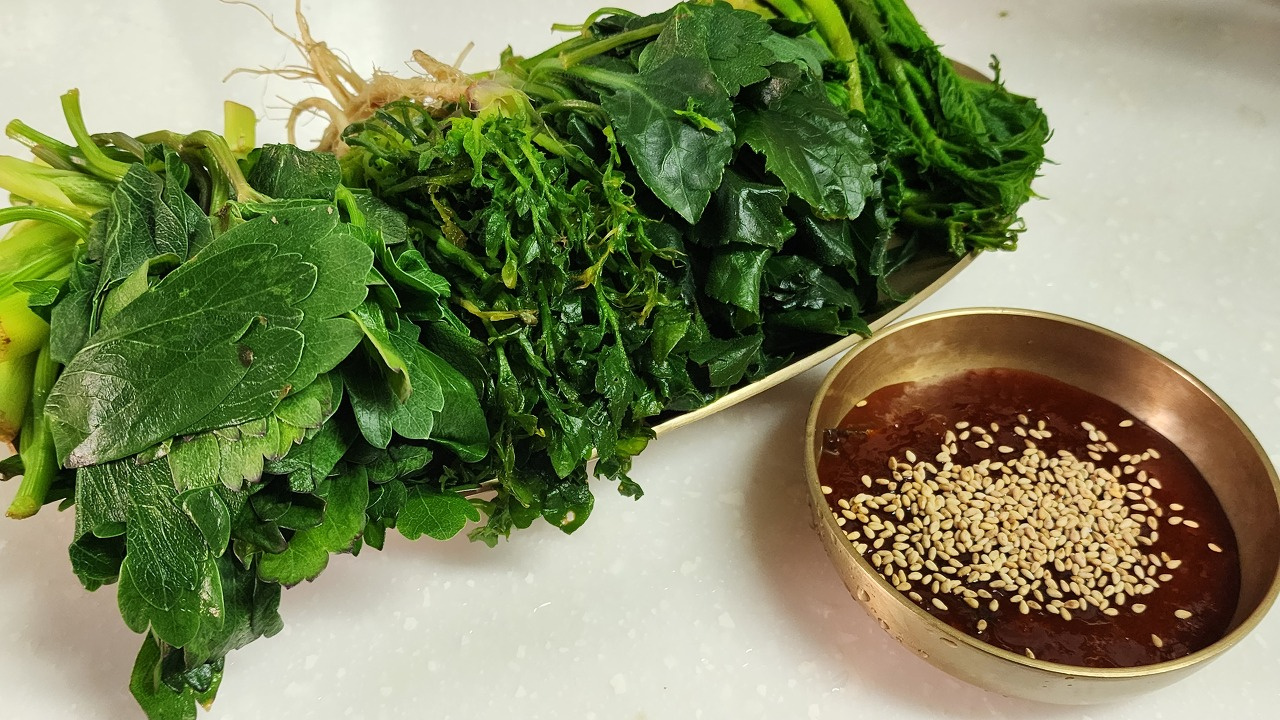Spring Wild Vegetable Salad & Mugwort Soup
Our Table Filled with the Essence of Spring

Spring truly brings joy and happiness. The fragrant aroma of wild spring vegetables, sprouting after enduring the winter, is delightful. This recipe captures the fresh flavors of spring for your dining table.
Fragrant Spring Wild Vegetable Salad- A handful of Dooreup (Korean Angelica Tree shoots) (approx. 100g)
- A handful of Bangpoongnamul (Glehnia root) (approx. 100g)
- A handful of Naengyi (Field cress) (approx. 100g)
- A handful of Chwinamul (Aster scaber) (approx. 100g)
- Chogochujang (spicy-sweet red pepper paste sauce) (to taste)
Savory Mugwort Soup- 100g Mugwort (clean and trimmed)
- 100g Clam meat (or other shellfish)
- 2 Tbsp Perilla seed powder
- 2 Tbsp Gukganjang (soy sauce for soup) or Fish sauce
- 4 cups Anchovy-Dashi broth (approx. 800ml)
- 100g Mugwort (clean and trimmed)
- 100g Clam meat (or other shellfish)
- 2 Tbsp Perilla seed powder
- 2 Tbsp Gukganjang (soy sauce for soup) or Fish sauce
- 4 cups Anchovy-Dashi broth (approx. 800ml)
Cooking Instructions
Step 1
Prepare the spring wild vegetables for the salad: Dooreup, Bangpoongnamul, Naengyi, and Chwinamul. If using Naengyi, wash it thoroughly to remove any soil. Bring a pot of water to a boil, add a pinch of salt (optional), and briefly blanch each type of vegetable for about 30 seconds to 1 minute. Be careful not to overcook, as they can become mushy. Immediately rinse the blanched vegetables under cold water to stop the cooking and drain them well, squeezing out excess water. This process helps retain their crisp texture and vibrant color.

Step 2
Trim the tough woody ends of the Dooreup. Remove the thick stems from Bangpoongnamul and Chwinamul, then cut them into bite-sized pieces. If the Naengyi stems are too long, cut them into 2-3 sections. (Blanching process is the same as in the previous step)

Step 3
Wash the Naengyi thoroughly to remove dirt. Bring a pot of water to a boil, add a pinch of salt (optional), and blanch the Naengyi for about 30 seconds to 1 minute. Rinse under cold water to cool, and gently squeeze out excess moisture. (Blanching process is the same as in the previous step)

Step 4
Place the squeezed wild vegetables in a bowl. Add Chogochujang to your preference and gently mix. Avoid vigorous mixing, which can make the vegetables mushy. Arrange the dressed wild vegetables beautifully on a serving plate. The spicy and sweet Chogochujang sauce enhances the natural fragrance of the vegetables.

Step 5
Now, let’s make the savory mugwort soup. In a pot, combine anchovies and dried kelp to make a rich broth. Once the broth is ready, remove the anchovies and kelp. Season the broth with Gukganjang or fish sauce for a savory depth. Start with about 2 tablespoons and adjust to taste.

Step 6
Add 2 tablespoons of perilla seed powder to the broth and stir well to dissolve. Stirring while it simmers will thicken the soup and give it a nutty flavor.

Step 7
Add the cleaned clam meat (or shellfish) to the soup and let it simmer. The clams will release their sweet, briny flavor into the broth. Bring it to a gentle boil.

Step 8
Once the soup begins to boil, add the thoroughly cleaned mugwort. Cook briefly, just until the mugwort wilts, about 1-2 minutes. Overcooking will diminish its fresh, herbal aroma.

Step 9
Ladle the savory mugwort soup into serving bowls. The combination of the mugwort’s aroma, the clams’ sweetness, and the nutty perilla seed powder creates a deeply satisfying dish that pairs perfectly with rice.

Step 10
Your spring wild vegetable salad and mugwort soup are ready! Enjoy a healthy and flavorful meal, brimming with the fresh essence of spring.




